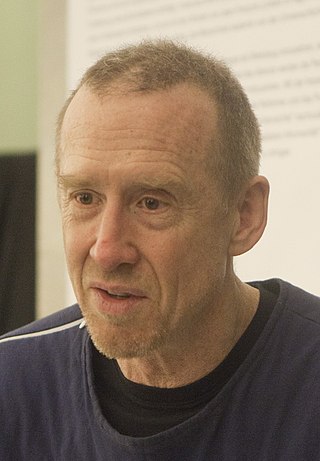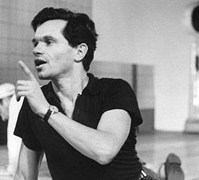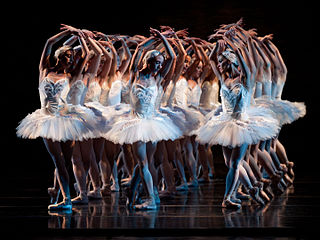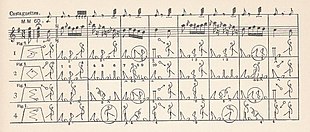
Ballet is a type of performance dance that originated during the Italian Renaissance in the fifteenth century and later developed into a concert dance form in France and Russia. It has since become a widespread and highly technical form of dance with its own vocabulary. Ballet has been influential globally and has defined the foundational techniques which are used in many other dance genres and cultures. Various schools around the world have incorporated their own cultures. As a result, ballet has evolved in distinct ways.

George Balanchine was an American ballet choreographer of Georgian origin, recognized as one of the most influential choreographers of the 20th-century. Styled as the father of American ballet, he co-founded the New York City Ballet and remained its artistic director for more than 35 years. His choreography is characterized by plotless ballets with minimal costume and décor, performed to classical and neoclassical music.

New York City Ballet (NYCB) is a ballet company founded in 1948 by choreographer George Balanchine and Lincoln Kirstein. Balanchine and Jerome Robbins are considered the founding choreographers of the company. Léon Barzin was the company's first music director. City Ballet grew out of earlier troupes: the Producing Company of the School of American Ballet, 1934; the American Ballet, 1935, and Ballet Caravan, 1936, which merged into American Ballet Caravan, 1941; and directly from the Ballet Society, 1946.

William Forsythe is an American dancer and choreographer formerly resident in Frankfurt am Main, Germany, and now based in Vermont. He is known for his work with the Ballet Frankfurt (1984–2004) and The Forsythe Company (2005–2015). Recognized for the integration of ballet and visual arts, which displayed both abstraction and forceful theatricality, his vision of choreography as an organizational practice has inspired him to produce numerous installations, films, and web-based knowledge creation, incorporating the spoken word and experimental music.

Michael Kidd was an American film and stage choreographer, dancer and actor, whose career spanned five decades, and who staged some of the leading Broadway and film musicals of the 1940s and 1950s. Kidd, strongly influenced by Charlie Chaplin and Léonide Massine, was an innovator in what came to be known as the "integrated musical", in which dance movements are integral to the plot.

Jerome Robbins was an American dancer, choreographer, film director, theatre director and producer who worked in classical ballet, on stage, film, and television.
Postmodern dance is a 20th century concert dance form that came into popularity in the early 1960s. While the term "postmodern" took on a different meaning when used to describe dance, the dance form did take inspiration from the ideologies of the wider postmodern movement, which "sought to deflate what it saw as overly pretentious and ultimately self-serving modernist views of art and the artist" and was, more generally, a departure from modernist ideals. Lacking stylistic homogeny, Postmodern dance was discerned mainly by its anti-modern dance sentiments rather than by its dance style. The dance form was a reaction to the compositional and presentational constraints of the preceding generation of modern dance, hailing the use of everyday movement as valid performance art and advocating for unconventional methods of dance composition.

Contemporary ballet is a genre of dance that incorporates elements of classical ballet and modern dance. It employs classical ballet technique and in many cases classical pointe technique as well, but allows a greater range of movement of the upper body and is not constrained to the rigorously defined body lines and forms found in traditional, classical ballet. Many of its attributes come from the ideas and innovations of 20th-century modern dance, including floor work and turn-in of the legs. The style also contains many movements emphasizing the body's flexibility.

Australian Dance Theatre (ADT), known as Meryl Tankard Australian Dance Theatre from 1993 to 1999, is a contemporary dance company based in Adelaide, South Australia, established in 1965 by Elizabeth Cameron Dalman. The ADT was the first modern dance company in Australia, and drew on the techniques of Martha Graham for its inspiration.

The Cincinnati Ballet is a professional ballet company founded as Cincinnati Civic Ballet in 1958, based in Cincinnati, Ohio, United States. After being registered as a company, it had its first performance in 1964.

Episodes is a ballet choreographed by Martha Graham and George Balanchine, to compositions by Anton Webern. The ballet was a co-production between the Martha Graham Dance Company and Balanchine's New York City Ballet (NYCB). Though it was conceived to be a collaboration between Graham and Balanchine, leading choreographers in modern dance and neoclassical ballet respectively, they ultimately worked separately on the ballet's two halves. Episodes I was choreographed by Graham, for dancers from her company and four NYCB members, and depicts Mary, Queen of Scots remembering the events in her life before her execution. Episodes II, by Balanchine, is completely plotless, and made for members of the NYCB and Graham dancer Paul Taylor, who originated a solo. The ballet uses all seven orchestral compositions by Webern.
Garry Stewart is an Australian dancer and choreographer. He was the longest-serving artistic director of the Australian Dance Theatre, taking over from Meryl Tankard in 1999 and finishing his term at the end of 2021. He is renowned for his unusual, post-modern interpretations of classical ballets.
Symphony in Three Movements is a neoclassical ballet choreographed by George Balanchine to the music of the same name by Stravinsky. The ballet was made for the New York City Ballet Stravinsky Festival in 1972, a tribute to the composer following his death. The ballet premiered on June 18, 1972, at the New York State Theater.
Lucinda Childs is an American postmodern dancer and choreographer. Her compositions are known for their minimalistic movements yet complex transitions. Childs is most famous for being able to turn the slightest movements into intricate choreography. Through her use of patterns, repetition, dialect, and technology, she has created a unique style of choreography that embraces experimentation and transdisciplinarity.

Modern dance is a broad genre of western concert or theatrical dance which includes dance styles such as ballet, folk, ethnic, religious, and social dancing; and primarily arose out of Europe and the United States in the late 19th and early 20th centuries. It was considered to have been developed as a rejection of, or rebellion against, classical ballet, and also a way to express social concerns like socioeconomic and cultural factors.

Concerto Barocco is a neoclassical ballet choreographed by George Balanchine to Bach's Concerto for Two Violins. Danced by a cast of eleven, the ballet is completely plotless, and according to Balanchine, "has no "subject matter" beyond the score which it is danced and the particular dancers who execute it". The ballet was made for the American Ballet Caravan's 1941 South American tour, and premiered on June 27, 1941, at Teatro Municipal, Rio de Janeiro. The ballet has entered the repertories of many ballet companies, including Balanchine's New York City Ballet.
The Tanja Liedtke Foundation is a German-based charity supporting modern and contemporary dance.

Tamaz Vashakidze is an artist, premier dancer of the State Georgian Ballet, choreographer, holder of the Order of Honor of Georgia (2001), founder and awardee of the Chabukiani-Balanchine International Festival of Ballet Art, founder of the New Georgian Ballet Theatre of Modern Dance, holder of Special Award of Balanchine's Family, and founder of the Foundation "Chabukiani-Balanchine".
Renato Zanella is an Italian-born ballet dancer, choreographer and director. He studied classical ballet for several years before becoming a choreographer for various professional companies. Due to his success, he has won many awards and honorary titles within the ballet community.

Guillaume Côté is a Canadian ballet dancer, choreographer, composer and artistic director. He is a principal dancer and a Choreographic Associate at the National Ballet of Canada. In February 2024, he announced that the 2024/2025 season will be his last season before retirement. He has been the Artistic Director of the Festival des Arts de Saint-Sauveur since 2014 and is the Artistic Director of Côté Danse.















